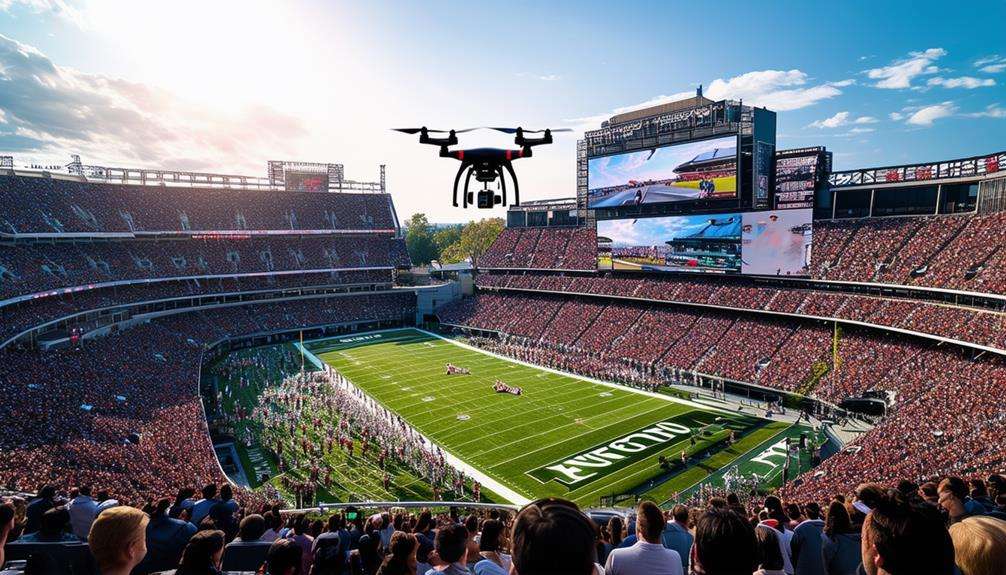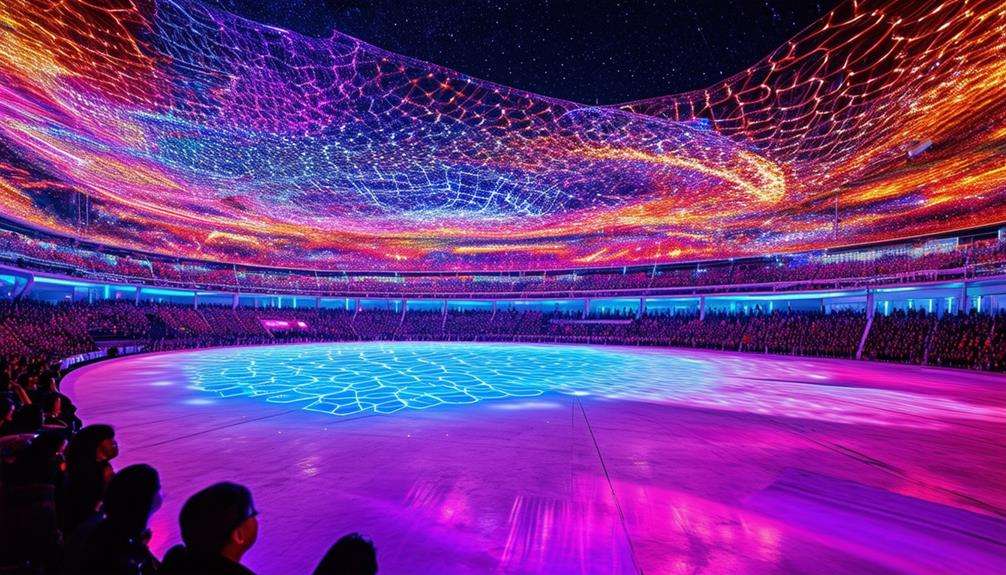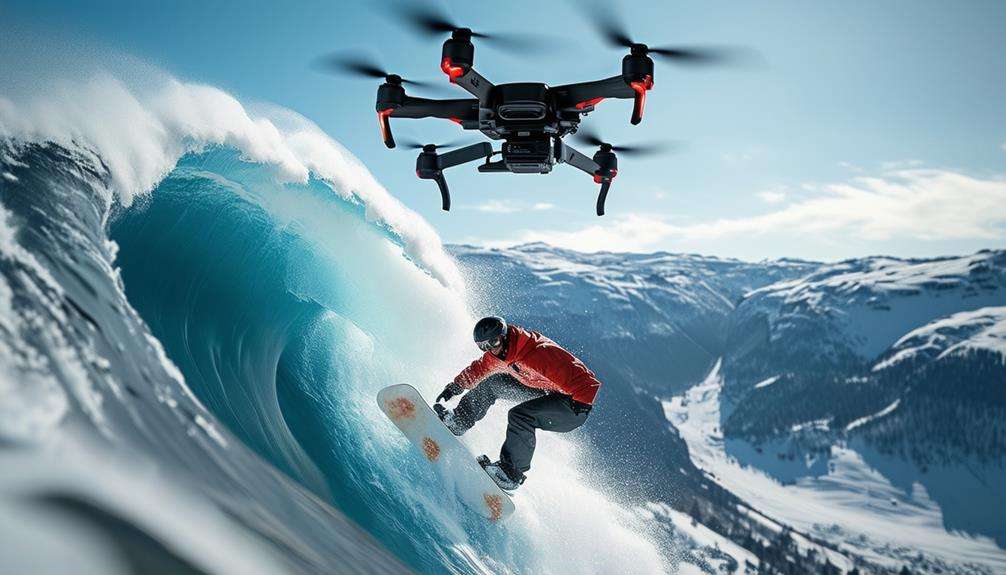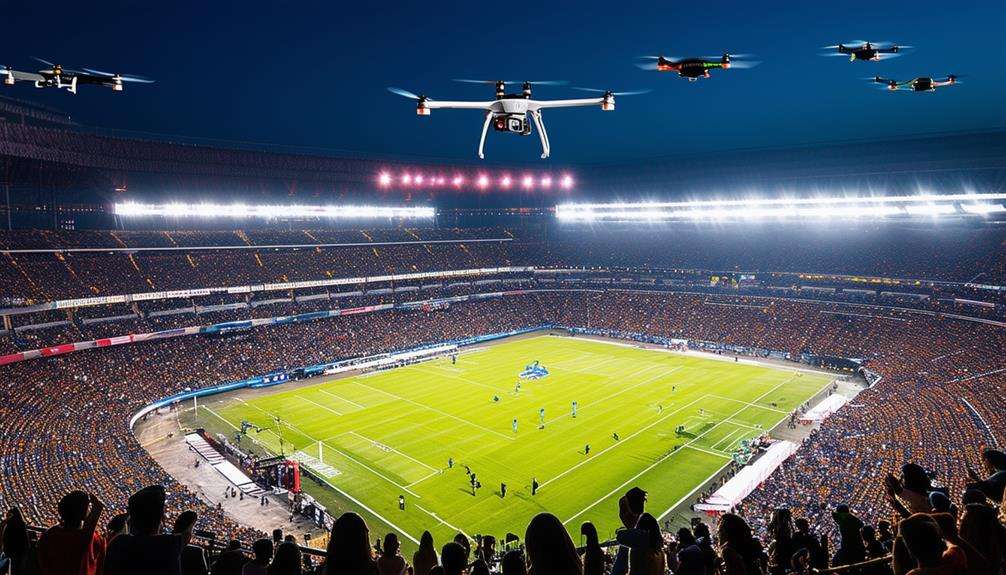How Drone Swarms Create Spectacular Light Shows
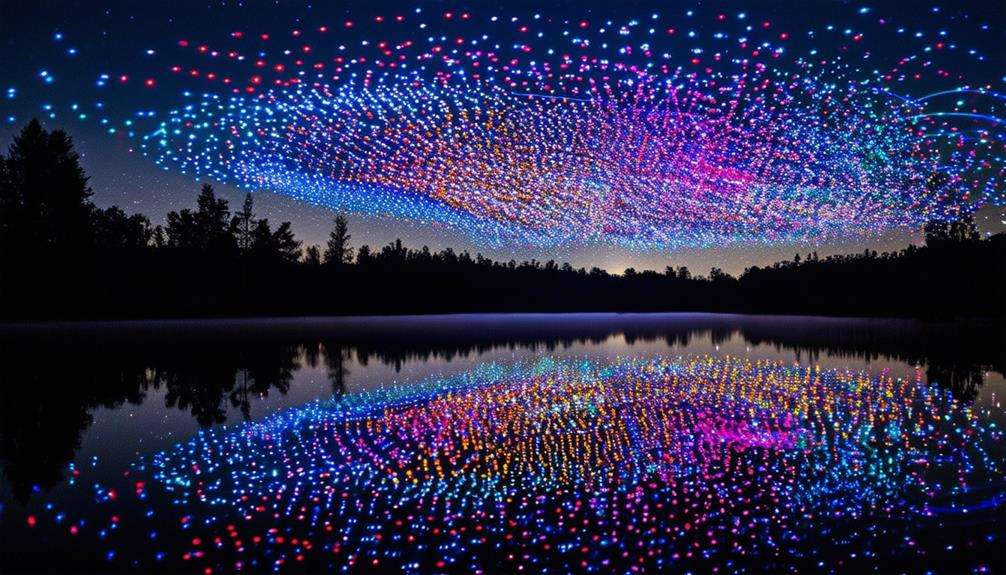
When you consider the magic behind drone light shows, it's intriguing to think about how multiple drones, each equipped with LED lights, create intricate patterns in the sky. How do these drones coordinate so seamlessly? Using real-time communication, synchronized flight algorithms, and precision GPS navigation, these swarms execute complex choreography without colliding. This blend of technology and artistry results in breathtaking displays that challenge traditional fireworks. But what exactly goes into planning and executing such a mesmerizing performance? Let's explore how these technological marvels come to life.
What Are Drone Light Shows?
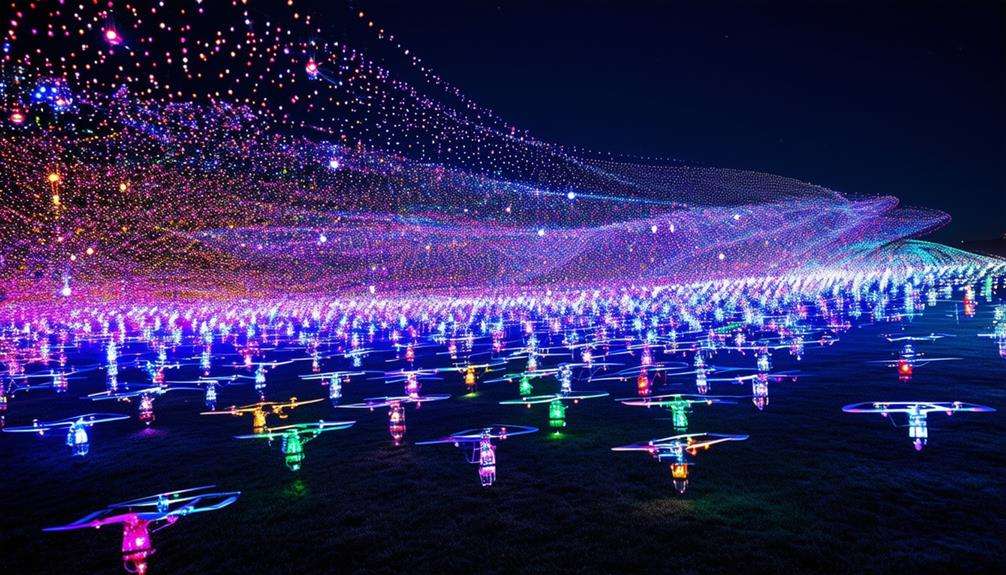
Drone light shows are captivating displays where fleets of small quadcopters equipped with LED lights create stunning visual spectacles in the night sky. These drones are programmed to follow precise flight paths, forming complex patterns, shapes, and even animations that are perfectly synchronized. Each drone's LED lights can change colors, enabling the creation of intricate and vibrant designs.
The shows are meticulously planned using sophisticated software, ensuring that every drone moves in harmony with the others. This centralized control results in a seamless aerial performance. The customization potential of drone light shows allows for unique animations and visual effects tailored to any event, making each show a one-of-a-kind experience.
Typically, these performances last around 10-15 minutes, constrained by the drones' battery life. In essence, drone light shows are a blend of advanced technology, creativity, and precise coordination, all working together to illuminate the sky with dazzling displays.
Key Technologies Used
To grasp the mesmerizing appeal of these light shows, it's essential to understand the key technologies behind them. Coordinated flight algorithms ensure each drone moves in perfect harmony, while real-time communication keeps them synchronized. Precision GPS navigation allows them to maintain exact positions, resulting in stunning visual effects.
Coordinated Flight Algorithms
Coordinated flight algorithms, utilizing real-time data from sensors such as accelerometers and gyroscopes, ensure each drone maintains its precise position in the sky. These algorithms are fundamental to synchronized aerial formations, enabling every drone in the swarm to move with precision and grace.
Central control stations play a crucial role by dispatching synchronized instructions to each drone, ensuring the entire swarm operates as a cohesive unit. Swarm intelligence algorithms enhance this capability by allowing drones to adapt their formations based on environmental changes or new performance requirements. This adaptability is vital for maintaining the fluidity and dynamism of the light show.
To ensure reliability and safety, redundant flight control systems are employed, providing backup controls in case of technical failures, thus guaranteeing smooth performance continuity. Moreover, fail-safe mechanisms are implemented to manage unexpected issues, such as loss of GPS signal or battery failures. These safety features are essential for preventing accidents and enabling drones to safely return to their designated positions.
Real-Time Communication
Real-time communication is essential for synchronizing the intricate movements of each drone in the swarm, leveraging technologies like Wi-Fi or RF. This ensures that every drone receives and executes commands simultaneously, maintaining the precise coordination required for a seamless light show.
Wireless protocols play a pivotal role, enabling rapid and reliable data exchange among the drones. Advanced software algorithms manage this data exchange, calculating optimal flight paths and formation changes in real-time. These algorithms ensure each drone is aware of its position relative to the others, achieving perfect synchronization.
Central control stations are at the core of the operation, sending immediate instructions to each drone for rapid adjustments during a live show. Whether it's a sudden change in wind conditions or an unexpected obstacle, the central control station can quickly direct the drones to adapt, ensuring the show continues smoothly.
To safeguard against signal interference or disruptions, redundant communication systems are implemented. These backup systems provide an extra layer of reliability, ensuring that even if one communication line fails, the drones remain in sync and the performance proceeds flawlessly.
Precision GPS Navigation
Precision GPS navigation is the cornerstone of synchronized drone light shows, ensuring each drone maintains its designated position and moves in unison to create stunning visual effects. Each drone is equipped with a GPS receiver, which allows it to determine its precise location in real-time. This capability is essential for achieving synchronized movements and adhering to predetermined flight paths.
Central control stations utilize GPS data to relay precise instructions to each drone. Here's how precision GPS navigation enables these captivating aerial displays:
- Accurate Positioning: GPS receivers on each drone provide real-time coordinates, ensuring precise location tracking.
- Synchronized Movements: Drones move in perfect harmony, creating seamless and cohesive formations.
- Designated Flight Paths: GPS ensures drones follow predefined routes, avoiding collisions and maintaining patterns.
- Central Control: Control stations use GPS data to dynamically manage and adjust drone positions.
- Visual Effects: Precise navigation allows for the creation of intricate and captivating light patterns.
This technology not only guarantees safety and precision but also enhances the overall visual experience of drone light shows.
Flight Control Systems
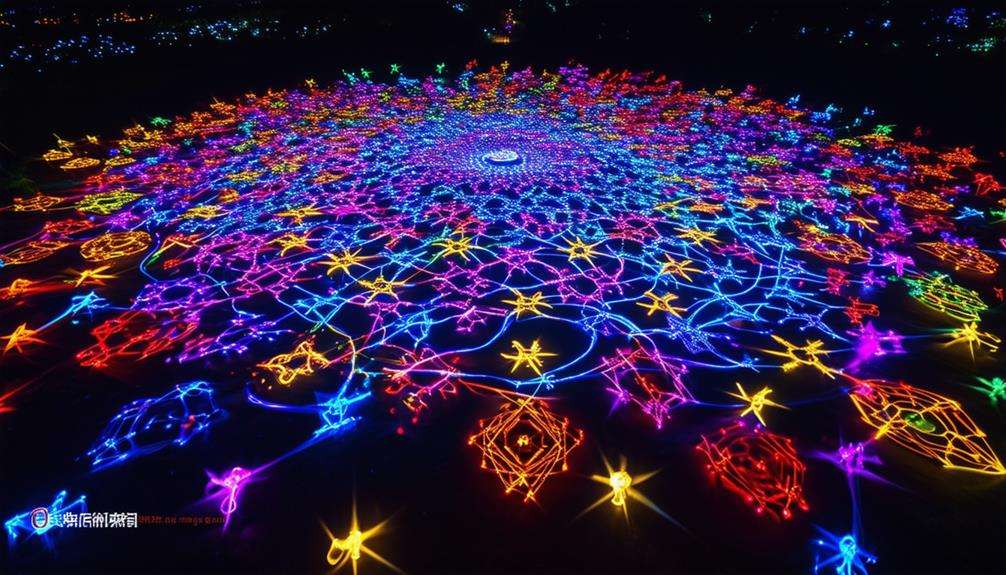
Essential synchronization algorithms are crucial in coordinating drones' movements. Real-time communication networks ensure each drone receives immediate updates, maintaining perfect swarm coordination. These systems together enable the stunning, unified displays that make drone light shows mesmerizing.
Precision Synchronization Algorithms
Drone light shows depend on advanced synchronization algorithms to achieve perfectly coordinated movements and formations. These algorithms are crucial for the operation of drone swarms, allowing them to create captivating aerial displays. By employing these algorithms, each drone in the swarm can move in harmony, resulting in dynamic visual spectacles that enthrall audiences.
Central control stations are integral to this process, transmitting synchronized instructions to all drones to ensure seamless coordination. Onboard sensors, such as accelerometers and gyroscopes, help maintain each drone's precise position, while real-time adjustments to motor speeds ensure they adhere to their designated flight paths.
Key components of these algorithms include:
- Precision Coordination: Drones' movements are meticulously timed to form intricate patterns and formations.
- Real-Time Adjustments: Continuous modifications to motor speeds keep drones on their precise paths.
- Synchronized Lighting: Lighting effects are perfectly synchronized with drone movements for stunning visuals.
- Centralized Control: A central control station manages the swarm, issuing coordinated commands.
- Dynamic Displays: Algorithms enable fluid and dynamic aerial displays that can change in real-time.
These advanced systems result in light shows that aren't only visually impressive but also exemplify precision engineering.
Real-Time Communication Networks
Real-time communication networks are crucial for orchestrating the intricate maneuvers of drone swarms in light shows. These networks depend on sophisticated flight control systems to ensure precise positioning and fluid movement. Onboard sensors, including accelerometers and gyroscopes, provide real-time data on each drone's position and orientation.
Advanced algorithms process this data to adjust motor speeds, ensuring each drone maintains its designated formation. Central control stations serve as the operation's command center, delivering real-time instructions to the drones. This coordination allows for synchronized movements and the creation of stunning light patterns.
Additionally, real-time communication networks incorporate swarm intelligence, enabling drones to swiftly adapt to environmental changes such as wind gusts or obstacles. This adaptability is crucial for preserving the integrity of the light show, guaranteeing flawless performances despite external variables.
Synchronization Techniques
To create captivating light shows, drone swarms rely on advanced synchronization techniques that ensure each drone moves in perfect harmony. Sophisticated flight control systems are crucial, utilizing onboard sensors like accelerometers and gyroscopes to maintain precise positions. This ensures that each drone accurately follows its predefined path, forming mesmerizing patterns in the sky.
Wireless communication protocols enable seamless coordination among drones. These protocols facilitate the sharing of positioning data and the reception of real-time instructions from central control stations. These stations are essential, as they send commands to synchronize all drones, making split-second adjustments as necessary.
Key aspects of synchronization in drone swarms include:
- Flight control systems: Use onboard sensors to maintain precise positioning.
- Wireless communication: Ensures seamless data exchange among drones.
- Central control stations: Provide real-time instructions for synchronization.
- Real-time adjustments: Allow drones to adapt to changing conditions.
- Swarm intelligence: Enables coordinated movements and the creation of complex patterns.
These elements collectively ensure the stunning and precise coordination required for drone light shows.
Swarm Intelligence
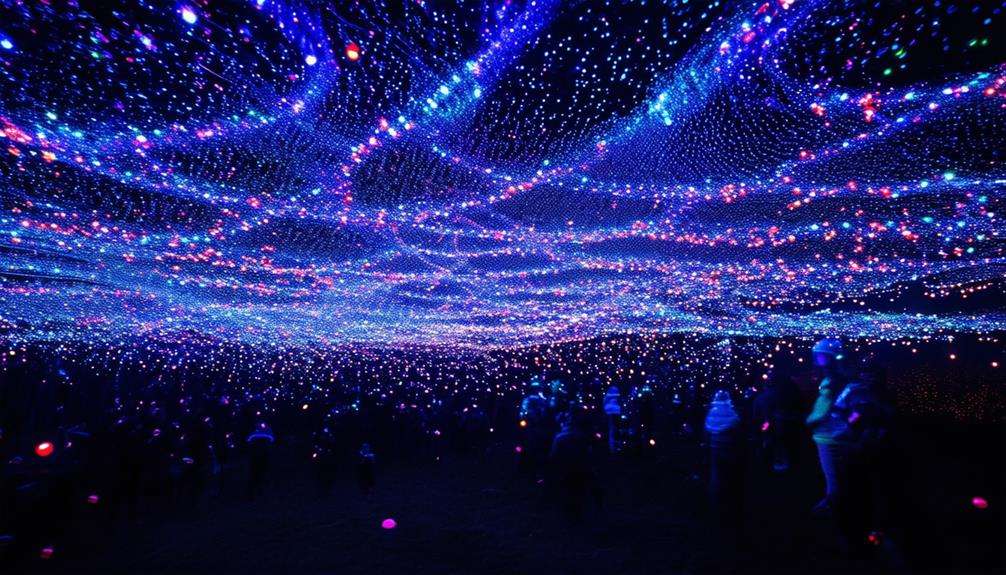
With swarm intelligence, drones coordinate their movements to create impressive visual displays. They process real-time data to avoid collisions and maintain precise formations, ensuring flawless performances. This technology allows drones to adapt dynamically, making each show a unique spectacle.
Coordinated Drone Movement
Utilizing cutting-edge algorithms, coordinated drone swarms create mesmerizing aerial formations through real-time adaptation and precise synchronization. These drones demonstrate collective behavior to deliver stunning light shows, a feat made possible by swarm intelligence that allows seamless communication and collaboration.
Wireless communication protocols are essential for this coordination. Each drone continuously shares its position and movement data with the others, ensuring perfect harmony. This real-time adaptability means that if one drone encounters an issue, the rest of the swarm can instantly adjust to maintain the formation.
Key elements include:
- Collective behavior: Drones operate as a cohesive unit, forming intricate patterns and designs.
- Real-time adaptation: Instant adjustments prevent collisions and maintain synchronization.
- Swarm intelligence: Algorithms enable drones to make decisions based on shared data.
- Wireless communication: Continuous data exchange keeps the swarm coordinated.
- Safety measures: Collision avoidance and redundant flight control systems enhance reliability.
These features make coordinated drone swarms not only fascinating but also trustworthy and operationally robust, ensuring both performance and safety.
Real-time Data Processing
In real-time data processing, drone swarms leverage advanced algorithms to adapt their movements instantly and maintain precise formations. Each drone seamlessly reacts to its neighbors, thanks to these sophisticated algorithms. This real-time adjustment is crucial for creating smooth, coordinated performances that captivate audiences.
Central control stations are pivotal in this process, sending precise instructions to each drone to ensure the swarm acts as a unified entity. This high level of coordination is achieved through swarm intelligence, where drones communicate and collaborate to produce synchronized displays. The result is stunning light shows that are both fluid and precise.
Here's a breakdown of how these elements work together:
| Key Component | Function | Outcome |
|---|---|---|
| Real-time Data Processing | Enables instant adaptation of drone movements | Enhanced fluidity and precision |
| Algorithms | Allow precise position and formation adjustments | Seamless drone interactions |
| Central Control Stations | Direct individual drones with precise instructions | Unified, coordinated performances |
| Swarm Intelligence | Facilitates communication and collaboration | Spectacular synchronized displays |
This integration ensures the drones operate cohesively, delivering awe-inspiring performances with high reliability and precision.
Safety Measures
To ensure safe and spectacular drone swarm light shows, advanced safety measures are implemented. These include collision avoidance systems and redundant flight controls. These features ensure that each drone maintains its designated position without crashing into others.
Collision avoidance systems are essential for preventing mid-air accidents, while redundant flight control systems provide backup in case of any technical failures. Fail-safe mechanisms add another layer of protection. These systems handle emergencies, ensuring drones can safely return to their starting point or continue the performance without issues.
Meticulously planned flight paths and altitudes minimize risks, keeping the drones well-coordinated and away from restricted areas. Safety is always a top priority in drone swarm light shows, and strict adherence to regulations and protocols is crucial for public safety.
Here's a summary of the safety measures:
- Collision avoidance systems to prevent mid-air crashes.
- Redundant flight control systems as backups for technical failures.
- Fail-safe mechanisms to manage emergencies.
- Carefully planned flight paths and altitudes to minimize risk.
- Strict adherence to regulations to ensure public safety.
Comparison With Fireworks

Drone light shows offer a sustainable and imaginative alternative to traditional fireworks, captivating audiences without the associated noise and pollution. Unlike fireworks, which produce loud booms and smoke, drones glide silently through the sky, creating intricate patterns and vibrant visuals. This makes them an eco-friendly option, ideal for environmentally conscious celebrations.
With customizable animations, drones can form any shape, image, or message, amplifying storytelling potential and allowing event organizers to craft narratives in the sky. Imagine watching a story unfold above you—something fireworks simply can't achieve.
The gradual shift from fireworks to drone light shows is occurring as more people recognize the benefits of this innovative entertainment medium. Drones don't just replace fireworks; they can also complement them, creating a more dynamic and visually stunning experience.
As drone technology becomes more affordable and accessible, expect to see these light shows at various events, from major city celebrations to corporate advertising campaigns. Embracing this new form of entertainment means participating in a movement towards a more sustainable and imaginative future.
Planning a Drone Show
Planning a drone show requires meticulous coordination and creativity to deliver a seamless and captivating performance. Begin by carefully designing the flight paths and formations for each drone, ensuring they move in perfect harmony. Specialized software aids in creating synchronized animations and detailed choreography, transforming the drones into breathtaking light displays.
Safety is of utmost importance. Consider airspace restrictions and develop comprehensive emergency protocols to handle any unforeseen situations. Each drone's flight program is transmitted from ground control stations, ensuring they adhere to the precise paths you've planned.
To ensure everything runs smoothly, preview the show using computer animations. This allows you to identify and resolve potential issues before the actual performance.
Here's a streamlined checklist to guide your planning:
- Detailed Flight Paths: Plan each drone's movement to prevent collisions and ensure stunning visuals.
- Engaging Choreography: Develop animations that turn the drones into a cohesive, dynamic light display.
- Safety Protocols: Implement strict airspace restrictions and emergency procedures.
- Ground Control Management: Use ground control stations to send specific flight programs to each drone.
- Pre-show Previews: Utilize computer animations to visualize the show and make necessary adjustments.
Cost Considerations

When considering a drone light show, you'll quickly realize that costs can vary widely based on the number of drones and the complexity of their animations. Small displays can start around $25,000, while larger, more intricate shows can range from $65,000 to $130,000. Balancing your budget with the visual impact you aim to achieve is crucial.
The high costs of drone performances stem from several factors. Advanced technology, including sophisticated software and high-quality drones, significantly contributes to the expense. Additionally, operational requirements such as skilled technicians, programming, and stringent safety measures further inflate costs. Compared to traditional fireworks, drone shows are generally more expensive but offer a modern and customizable alternative.
High costs remain a significant barrier, impacting the accessibility of drone shows for many events and marketing purposes. While prices can vary based on scale and intricacy, meticulous planning is essential.
Future of Drone Shows
Looking ahead, drone light shows will evolve with cutting-edge technology, offering greater creative possibilities. Future advancements will enable drones to execute more adaptive movements, resulting in intricate and stunning displays. These improvements will enhance visual appeal and open new avenues for storytelling and artistic expression.
Drone shows are set to become an environmentally friendly alternative to traditional fireworks, significantly reducing pollution and wildfire risks. As a reusable form of entertainment, drones offer sustainability that fireworks can't match. This shift will likely make drone light shows a staple at various events, from grand festivals to local celebrations like Guy Fawkes Night.
Here are some exciting prospects for the future of drone shows:
- Advanced Technology: More sophisticated drones capable of complex and adaptive movements.
- Environmental Benefits: Reduced pollution and wildfire risks compared to fireworks.
- Sustainability: A reusable entertainment option that minimizes waste.
- Community Integration: Expansion into smaller, community-based events.
- Innovation and Accessibility: Continuous improvements making drone shows more accessible to a wider audience.
With ongoing innovation and increased accessibility, drone light shows are poised to become a mainstream entertainment option, captivating audiences everywhere.
Conclusion
Prepare to be amazed by how drone swarms create breathtaking light shows through cutting-edge technology and precise coordination. Compared to traditional fireworks, drone shows are safer, more versatile, and environmentally friendly. When planning a drone show, consider the cost, but know that you're investing in the future of entertainment. With advancements in swarm intelligence and flight control, the sky's the limit for what these dazzling displays can achieve. So get ready to be mesmerized!

